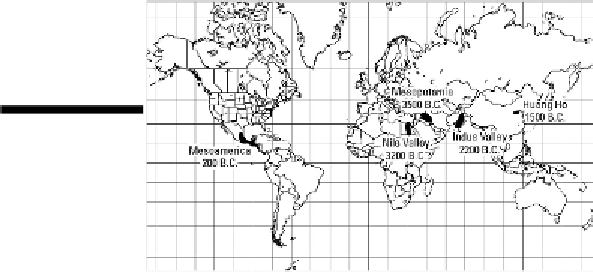Geography Reference
In-Depth Information
Figure 17-2:
Locations of urb-
an hearths.
Trade and commerce played important roles in the growth and development of hearth-area cities. But
so, too, did the need for centers for religious rituals and observances. As a result, imposing structures
of ceremonial significance (such as pyramids and temples) dominated “skylines.” These tended to be
located alongside or at the intersection of broad boulevards aligned in directions that often had theo-
logical significance. Complementing these imposing structures were achievements of more mundane,
yet fundamental, varieties. Yesterday's cities (yes, even without traffic lights and fast-food restaur-
ants, they're still considered cities), with populations that probably didn't exceed 25,000, showcased
distinct residential, commercial, and institutional zones, as well as municipal services such as water
supply and garbage removal. These prove that municipal planning and governments were at work
even back then. Thus, the urban hearth areas were scenes of important experiments and innovations
in human settlement, the results of which were passed down to succeeding generations, modified, and
ultimately spread to other lands.
Geographically, what is perhaps most important about these hearths is their locations. Each
coincided with an area of high agricultural productivity. This positioning made a great deal
of sense because the principal prerequisite for the appearance and growth of cities is an agri-
cultural surplus. Why? Because that alone frees some people of the necessity to produce food
and allows them to become artisans, traders, shopkeepers, soldiers, clerics, and so on, and
cluster in settlements — cities — that promote the interaction of those services. Accordingly,
each hearth (except Meso-America) is located amidst fruitful lands that roughlyparallel one or
more large rivers. The richness of the soils, whose fertility was regenerated by silts deposited
byperiodicfloods,allowedpeoplewitheventhemostbasicagriculturaltechnologytoproduce
good harvests (food surpluses) on a regular basis. Each hearth (including Meso-America) was
also noted for impressive irrigation systems that maximized the agricultural potential of local
waters and soils. Given the significance of these water systems, whether natural or human in
origin, the early cities and their peoples are sometimes referred to as
hydraulic civilizations
.



